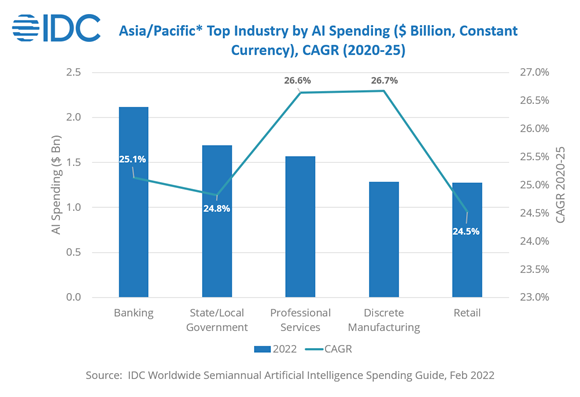 According to IDC's latest Worldwide Artificial Intelligence Spending Guide, spending on AI systems in the Asia Pacific region will rise from $17.6 billion in 2022 to around $32 billion in 2025.
According to IDC's latest Worldwide Artificial Intelligence Spending Guide, spending on AI systems in the Asia Pacific region will rise from $17.6 billion in 2022 to around $32 billion in 2025.
Businesses invest in artificial intelligence (AI) to gain a competitive advantage through improved customer insight, increased employee efficiency, and accelerated decision making. IDC forecasts a compound annual growth rate (CAGR) of 25.2% for the period 2020–2025. “Many of the changes caused by the pandemic will stay and we expect the adoption momentum of practical AI use cases such as remote or contactless engagement to continue. In the long term, a clear guidance on the management of the associated risk factors of AI solutions will further boost the confidence level of buying organizations,” says Jessie Danqing Cai, Associate Research Director, Cognitive Computing / Artificial Intelligence for IDC Asia/Pacific.
“Many of the changes caused by the pandemic will stay and we expect the adoption momentum of practical AI use cases such as remote or contactless engagement to continue. In the long term, a clear guidance on the management of the associated risk factors of AI solutions will further boost the confidence level of buying organizations,” says Jessie Danqing Cai, Associate Research Director, Cognitive Computing / Artificial Intelligence for IDC Asia/Pacific.
Over the next five years, the banking industry will continue to invest the most in AI solutions. Risk mitigation would be vital for the banking industry's AI investment through augmented threat intelligence and fraud analysis applications.
State/Local government is the second-highest spender on AI solutions, focusing on public safety and emergency response, augmented threat intelligence, and prevention systems.
The next top spending industry is professional services, growing fast with 26.6% (CAGR) and the key focus area is augmented customer service agents which help resolve customer issues. Smart business innovation and automation will optimize and streamline complex and repetitive business tasks to support organizational decision-making.
"Increasing government regulations and mandates of AI's trust, robustness, and its ethical use will need to be addressed by organizations," says Vinayaka Venkatesh, Senior Market Analyst at IDC IT Spending Guides, Customer Insights & Analysis." Customer-facing industries such as financial services, hospitality and tourism will take the lead in addressing these government mandates," Venkatesh adds. The top five use cases account for $6.1 billion, or 34.5% of total AI spending, and are forecasted to grow to 10.8 billion by 2025. Investments in use cases such as augmented customer service agents, sales process recommendation and augmentation, and smart business innovation and automation solutions are pervasive across all industries. These solutions enable organizations to provide a better customer experience while also saving time in the decision-making process. State and local governments are spending more than 64.3% of total AI spending on public safety and emergency response solutions that address new and emerging threats and improve emergency/disaster planning and response. Similarly, the Banking Securities Finance and Insurance (BSFI) sector invests around 25% of total AI spending on fraud analysis and investigation AI solutions to detect fraudulent transactions and anomalies.
The top five use cases account for $6.1 billion, or 34.5% of total AI spending, and are forecasted to grow to 10.8 billion by 2025. Investments in use cases such as augmented customer service agents, sales process recommendation and augmentation, and smart business innovation and automation solutions are pervasive across all industries. These solutions enable organizations to provide a better customer experience while also saving time in the decision-making process. State and local governments are spending more than 64.3% of total AI spending on public safety and emergency response solutions that address new and emerging threats and improve emergency/disaster planning and response. Similarly, the Banking Securities Finance and Insurance (BSFI) sector invests around 25% of total AI spending on fraud analysis and investigation AI solutions to detect fraudulent transactions and anomalies.
Hardware will be the leading technology, accounting for more than 49.8% of AI spending; the largest areas of investment will be in servers, accounting for more than 84% of total spending, while the rest will go toward storage. Software is the second leading technology with 31% of AI spending. While 71% of total AI spending in software goes towards AI applications and platforms. Services has the fastest spending growth, with a five-year CAGR of 34.3% in technology.
The Worldwide Artificial Intelligence Spending Guide sizes spending for technologies that analyze, organize, access, and provide advisory services based on a range of unstructured information. The “Spending Guide” quantifies the AI opportunity by providing data for 29 use cases across 19 industries in nine regions and 32 countries. Data is also available for the related hardware, software, and services categories.
By MediaBUZZ


